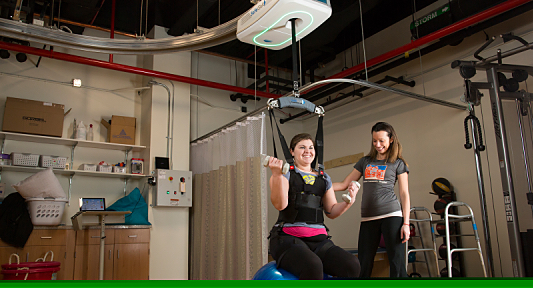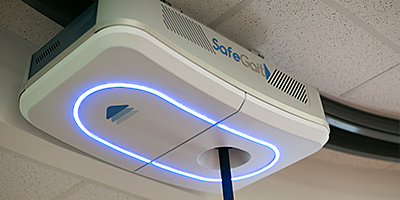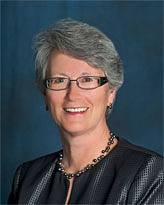University to Use New Balance and Mobility Trainer for Therapy, Research
Written by |

 The University of St. Augustine for Health Sciences (USAHS) recently installed a state-of-the-art SafeGait 360 Balance and Mobility Trainer on its Austin, Texas campus. The device is a ceiling-mounted body-weight support and fall protection system that tracks patient movements 2,500 times per second.
The University of St. Augustine for Health Sciences (USAHS) recently installed a state-of-the-art SafeGait 360 Balance and Mobility Trainer on its Austin, Texas campus. The device is a ceiling-mounted body-weight support and fall protection system that tracks patient movements 2,500 times per second.
The trainer was designed in collaboration with physical therapy and occupational therapy experts to mitigate risk of injury from falls. It’s used to treat people who have multiple sclerosis or spina bifida, or with neurological problems such as a stroke, spinal cord injury, traumatic brain injury, as well as geriatric patients who are at risk of injury from falls.
 Additionally, the SafeGait 360’s Dynamic Fall Protection (DFP) feature is programmed to distinguish between a patient’s intentional downward movement and when the patient is actually falling, allowing therapists to easily fine-tune the system’s fall protection sensitivity to accommodate and challenge individual patients at varying stages of independence.
Additionally, the SafeGait 360’s Dynamic Fall Protection (DFP) feature is programmed to distinguish between a patient’s intentional downward movement and when the patient is actually falling, allowing therapists to easily fine-tune the system’s fall protection sensitivity to accommodate and challenge individual patients at varying stages of independence.
DFP, the system’s primary mode of protecting patients, is always active and provides protection during standing, sitting, stair and floor tasks. SafeGait 360’s manufacturer, Gorbel Medical, notes that DFP promotes increased intensity and challenge so patients can “fail” safely and initiate correction while being dynamically supported and protected without disruption.
 SafeGait 360’s proprietary Patient Management Software offers a user-friendly interface that tracks and documents key performance measures in real-time, including data for time, distance, repetitions, falls prevented, average body weight support, and speed documented by session and task. The software interface features a Plan of Care library, and therapists can compare outcomes in chart or detailed summary formats, and export data.
SafeGait 360’s proprietary Patient Management Software offers a user-friendly interface that tracks and documents key performance measures in real-time, including data for time, distance, repetitions, falls prevented, average body weight support, and speed documented by session and task. The software interface features a Plan of Care library, and therapists can compare outcomes in chart or detailed summary formats, and export data.
 An overhead actuator unweights, protects and moves with the patient in one-on-one sessions with their therapist, allowing therapist-controlled, adjustable unloading of patients up to 50 percent of their weight (175 pounds maximum), and adjustment of fall protection sensitivity to accommodate patients at varying stages of independence: high, medium, and low.
An overhead actuator unweights, protects and moves with the patient in one-on-one sessions with their therapist, allowing therapist-controlled, adjustable unloading of patients up to 50 percent of their weight (175 pounds maximum), and adjustment of fall protection sensitivity to accommodate patients at varying stages of independence: high, medium, and low.
The system’s single-rail design features an integrated power bar that allows the patient to travel in a smooth monorail-like fashion, unlike some rail systems that have an attached power cord preventing full loop configurations. SafeGait’s integrated rail system can be customized to accommodate many configurations including loop, straight, J-shaped, and  horseshoe.
horseshoe.
Physical therapists are regularly at risk of strains or injuries associated with patient handling and movement during therapy, with risk of injury from falls during therapy threatening the safety of both patients and therapists, and associated costs creating a substantial burden on the facility. The use of SafeGait in risk reduction protocols protects therapists and patients without compromising the therapy.
 USAHS is one of the first higher education institutions in America to install a SafeGait 360 system. In addition to conducting research with patients and students, USAHS faculty members with experience in using BWS equipment intend to open a clinic providing new treatment options to patients in the Austin community. The clinic will begin seeing patients this month.
USAHS is one of the first higher education institutions in America to install a SafeGait 360 system. In addition to conducting research with patients and students, USAHS faculty members with experience in using BWS equipment intend to open a clinic providing new treatment options to patients in the Austin community. The clinic will begin seeing patients this month.
 “My interest in using body-weight support systems to treat patients began when I was a clinician,” Elizabeth Ardolino, PT, MPT, MS, PhD, assistant professor of neurology and research at USAHS, said in a press release.
“My interest in using body-weight support systems to treat patients began when I was a clinician,” Elizabeth Ardolino, PT, MPT, MS, PhD, assistant professor of neurology and research at USAHS, said in a press release.
“I was passionate about bringing SafeGait 360 to our institution because there is no equipment like this in the immediate Austin area,” said Ardolino, a physical therapist. “At USAHS, we are able to offer our expertise to people in our local community who need it most: patients with neurological injuries, geriatric patients, patients who have been discharged from traditional physical therapy treatments, and patients who may not have the health insurance benefits to cover extensive therapeutic care.”
In addition, the SafeGait 360 will be used for research and to provide treatment for orthopedic and geriatric patients, who are also at risk of injury from falls.
 “When someone suffers from medical issues or injuries and is learning to walk again, one of the top fears that comes to the individual is the fear of falling,” said USAHS president and chief academic officer Dr. Wanda Nitsch, who has also been a physical therapist for 32 years. “With the innovative SafeGait 360, those individuals can bypass this fear and gain the necessary confidence needed in their treatment plan. This technology is revolutionary and will provide our faculty and students with a great hands-on learning experience.”
“When someone suffers from medical issues or injuries and is learning to walk again, one of the top fears that comes to the individual is the fear of falling,” said USAHS president and chief academic officer Dr. Wanda Nitsch, who has also been a physical therapist for 32 years. “With the innovative SafeGait 360, those individuals can bypass this fear and gain the necessary confidence needed in their treatment plan. This technology is revolutionary and will provide our faculty and students with a great hands-on learning experience.”
USAHS says many of its faculty members are planning to use SafeGait 360 to conduct research with both students and patients. “I plan to use SafeGait 360 in three ways: in the classroom, in the community and through research,” Ardolino said. “This fall, we plan to launch a study on children with spina bifida. We will be testing a tool designed to measure how children with spinal cord injuries and spina bifida recover after their injury, and part of that tool requires the use of a body-weight piece of equipment. SafeGait 360 allows us to really test that tool to the full extent of its capability.”
“It’s important to know and understand what has worked from a research standpoint, and how to translate that into the clinic,” Ardolino added. “There’s a difference between having the equipment and knowing what to do with it, and having the theoretical foundation behind why you’re using the equipment the way you are with the patient. We are incorporating SafeGait 360 into our students’ coursework and labs so that when they graduate from USAHS, they will really know how to use a body-weight support system, and how to use it well.”
Currently, USAHS students work in Patient Oriented Integrated Neurological Treatment (POINT) labs, with real-life patients under the guidance of faculty members. The USAHS POINT labs bring patients with neurological disorders into the classroom to be evaluated and treated by students over a four-week period.
“Most graduate physical therapy and occupational therapy institutions do not have this type of innovative equipment on their campus, accessible to both faculty and students to use with local patients,” Nitsch said. “Our students will be trained on the equipment from faculty experts, and have the opportunity to work with patients and see the positive impact the use of this equipment can have on their treatment, their progress, and their lives.”
Brian Reh, Gorbel Medical president and CEO, added, “while it might seem more common to have products like SafeGait solely in a hospital setting, USAHS goes beyond and is leveraging the technology across the university model. I find it special and unique for a university to bring new innovations to students, to their community and to research.”
For more information, visit https://usa.edu, https://safegait.com/360-balance-mobility-trainer/, and https://www.gorbel.com/





